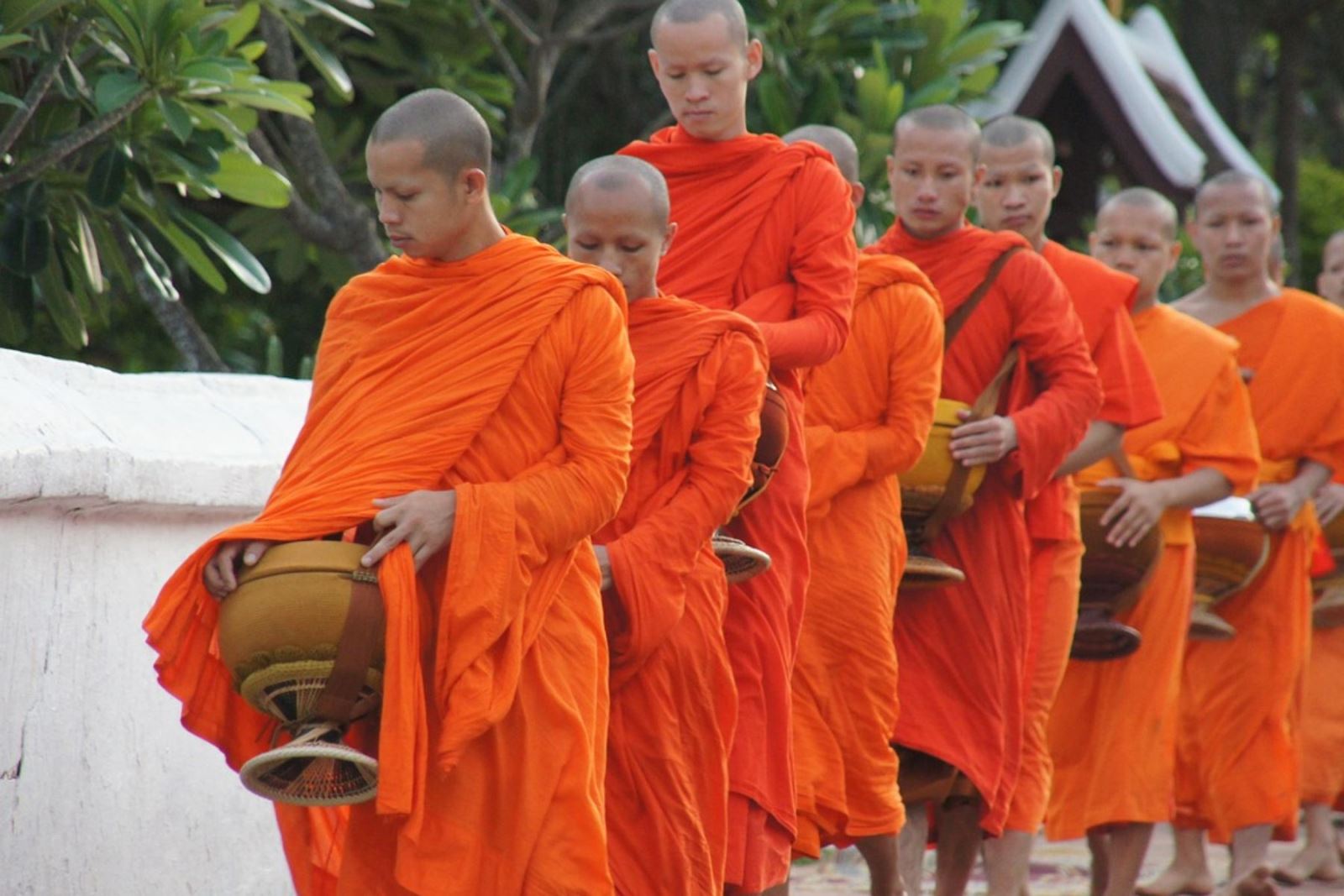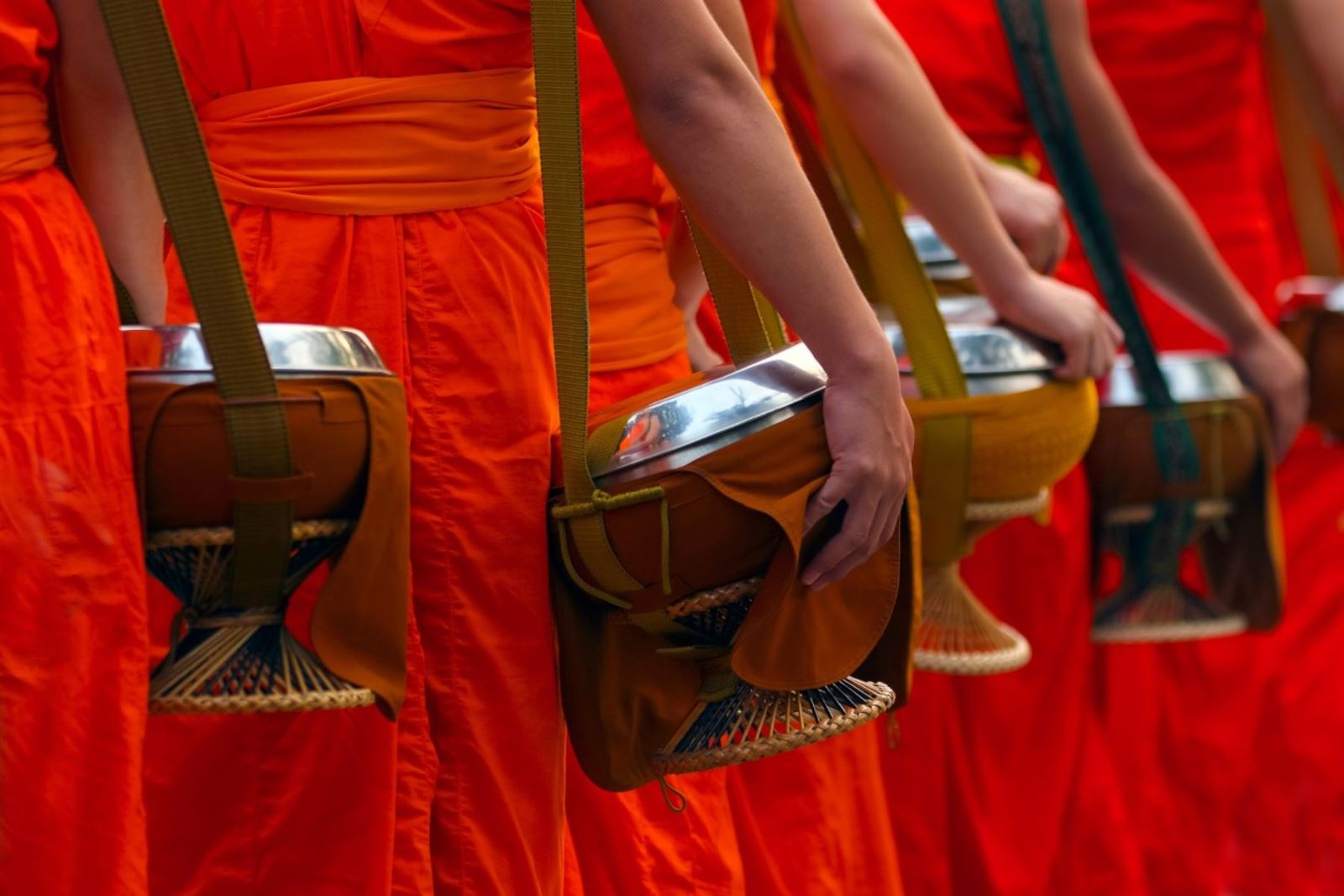Tak Bat, a symbolic ritual in Buddhism, represents a beautiful tradition where devotees seek alms, weave connections of merit, and work to awaken sentient beings. Practiced in Southeast Asian countries such as Thailand, Myanmar, Cambodia, and Laos, where Buddhism is the national religion, this ceremony holds significant cultural importance.
In Laos, Tak Bat has been a spiritual heartbeat for centuries. Many foreign tourists, captivated by this tradition, have attended and participated in the morning alms-giving ceremony. However, few among them fully comprehend the precise proceedings of the ritual or its profound significance. Follow us as we explore this tradition together.
Tak Bat, a symbolic ritual in Buddhism, represents a beautiful tradition where devotees seek alms, weave connections of merit, and work to awaken sentient beings. Practiced in Southeast Asian countries such as Thailand, Myanmar, Cambodia, and Laos, where Buddhism is the national religion, this ceremony holds significant cultural importance.
In Laos, Tak Bat has been a spiritual heartbeat for centuries. Many foreign tourists, captivated by this tradition, have attended and participated in the morning alms-giving ceremony. However, few among them fully comprehend the precise proceedings of the ritual or its profound significance. Follow us as we explore this tradition together.
1. Tak Bat, a sacred practice of Primitive Buddhism
Tak Bat, or the almsgiving ceremony of monks, remains a sacred practice of Primitive Buddhism, especially prevalent in Southeast Asian countries like Laos. Every morning, monks clad in orange leave the temple to receive alms from the devotees. These contributions, often consisting of rice and other foods, are offered with reverence in the monks' bowls, reflecting the goodwill of the local people and tourists.
In addition to receiving these offerings, the monks also pray for the merit of the almsgivers. This tradition binds the generosity of the faithful with the spiritual essence of the monks, illustrating the selflessness of the monks who share their blessings with those making offerings.
This daily practice is crucial for Buddhist practitioners, liberating monks from material concerns and allowing them to focus on their spiritual journey. Moreover, it guides the faithful to avoid excessive attachment to material possessions.
Tak Bat is not just a tradition but also a vivid lesson in generosity and humility. It embodies the essence of Buddhism, where sharing and compassion are expressed through this daily practice, bringing blessings to both the monks and the almsgivers, nurturing the minds and hearts of all participants.

2. How does Tak Bat happen?
Most Laotians are Buddhists, following the Theravada branch of Buddhism. It is common to see barefoot monks silently walking on the streets each morning to receive alms. Meanwhile, local residents prepare food to share with the monks, dedicating themselves as they believe the monks deserve such offerings. By providing delicious meals, they also consider offering food to their deceased loved ones.
According to the rules of Theravada Buddhism, only fully cooked food can be offered. Therefore, alms often include a handful of cooked sticky rice, homemade cakes, fruits, packaged snacks, canned and fresh milk, among other items.
Participants usually kneel barefoot along the road, in silent anticipation as the monks pass by to respectfully offer alms. Before placing the food in the monks' bowls, people offer brief prayers, and the monks, in turn, bless the almsgivers.
Monks only eat in the morning, accepting pre-cooked food, visiting no more than 7 households, without distinguishing between rich or poor, good or bad food. They do not position themselves in front of market doors. The collected food is shared with the poor and used by the monks for their only daily meal.
The entire ceremony takes place in silence, implying that all participants, including tourist attendees of Tak Bat, must maintain composure and show respect.

3. Tak Bat sightseeings
As a symbolic ritual, Tak Bat captivates foreign tourists, moved by the beauty of this sacred moment. In countries like Thailand, Myanmar, Cambodia, and Laos, where Theravada Buddhism is widely practiced, this ceremony can easily be witnessed throughout the cities. Below are some of the best locations to provide you with a special experience:
In Laos:
With over 30 temples and pagodas, it's hard to find a city more spiritually inclined than Luang Prabang. These temples are notable not only for their beautiful architecture, characterized by sloping roofs nearly touching the ground and colorful wall paintings depicting the past lives of the Buddha but also for being home to about a thousand monks preserving the traditions and spirit of the former capital, Luang Pha Bang. Therefore, the Tak Bat ceremony is perhaps most notably attractive in Luang Prabang.
Monks typically start their day around 4 a.m. with a morning chanting session before heading out for the Tak Bat procession. Since the sunrise in Luang Prabang varies from 5:30 a.m. to 6:45 a.m. depending on the season, almsgiving can take place before dawn in winter.
The solemn atmosphere of the almsgiving ceremony in Luang Prabang is more pronounced than anywhere else. This is due to the large number of participating monks and the involvement of the local community. The city offers various locations where you can observe the almsgiving ceremony, each providing a unique experience:
Sakkaline Street: Located in the center of the old city with famous temples such as Wat Xieng Thong and Wat Sene. The street also has restaurants and cafes where you can have breakfast before or after the ceremony.
Along the Mekong River: The scenery of the river brings serenity to the ceremony. You can also see local fishermen on their boats. Among the famous temples along the Mekong River are Wat Phon Phao and Wat Long Khoun.
In the outskirts: For a quieter experience, some less crowded temples offer a more authentic feel. Among them, Wat Siphoutthabath and Wat Nong Sikhounmuang are worth visiting.
